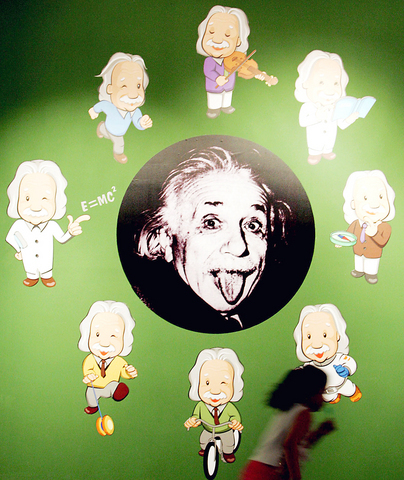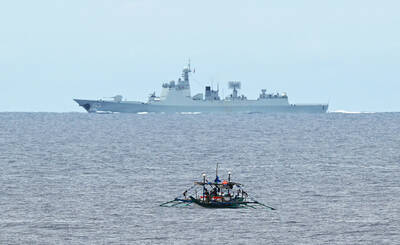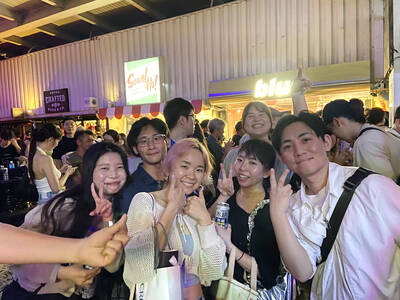The 100th anniversary of Albert Einstein's annus mirabilis has not passed quietly. Newspapers, magazines and TV documentaries have all trumpeted the year in which Einstein published five papers rethinking the laws of time and space. This year also marks the 50th anniversary of the former patent clerk's death.
Yet lying between these two dates is a less well-known anniversary. It is 74 years since Einstein attended the only seance of his life. What could have persuaded Einstein to attend such an unscientific event?
By 1930 Einstein was one of the most famous people on the planet. His general theory of relativity (with a little help from E=mc2) had thrust him into the spotlight as the foremost proponent of the new scientific age. Knowing of his plans to leave Germany, the world's leading universities tried to tempt him to their campuses.

PHOTO: AP
It was the offer from the California Institute of Technology (Caltech) in Pasadena, on the outskirts of Los Angeles, that proved most enticing, thanks to their top astronomer, Edwin Hubble, who had seen distant galaxies streaking away from Earth through his 250cm telescope. Here was proof that the universe was expanding, an observation that refuted Einstein's view of the universe as a fixed sphere. Intrigued, he and his wife traveled west in 1931.
In Pasadena, the 51-year-old Einstein found solace in the company of one of the locale's most notorious gadflies, the author Upton Sinclair. The Michael Moore of his time, Sinclair's The Jungle (1906) had exposed the unsanitary conditions and labor exploitation rife in Chicago's meat-packing industry. The book caused a national outcry and so horrified former president Theodore Roosevelt that he reputedly threw his sausages out of the White House window.
Sinclair went on to write further jeremiads against big business, yet his latest project was quite different. He had become obsessed with extra-sensory perception and had written a book, Mental Radio (1930), about experiments he had conducted that seemed to prove telepathy's existence.
Sinclair had sent Einstein a copy of Mental Radio before his arrival in the US. Einstein was a great admirer of Sinclair's previous, muckraking works and offered to write an open-minded, if ultimately non-committal, preface.
The two became the closest of friends. Einstein wrote telegrams of support for the striking workers that Sinclair championed, and Sinclair provided Einstein with a break from celebrity and science, taking him to the cinema to see All Quiet on the Western Front, which had been banned in Germany as pacifist propaganda.
Other than in the preface to Mental Radio, Einstein had never professed any kind of interest, let alone belief, in supernatural beings or extra-sensory powers. "Even if I saw a ghost," he once said, "I wouldn't believe it." But Sinclair was excited by the prospect and thought that this was his best chance to convert Einstein to his cause.
Count Roman Ostoja was a muscular, dark-eyed man who claimed to be a Polish aristocrat, although he was really from Cleveland, Ohio. He had been working the west coast under the stage name of Nostradamus and gained plaudits for being buried underground in a coffin for three hours. He claimed to have studied under "occult masters" in India and Tibet and had wowed Sinclair with his mind-reading.
Nevertheless, Ostoja must have been slightly overawed by what was now suggested to him. Sinclair wanted Ostoja to conduct a seance at his house to which would be invited not only Einstein, but Richard Tolman, soon to be chief scientific adviser to the Manhattan Project, and Paul Epstein, Caltech's professor of theoretical physics. When the evening came, Sinclair addressed the learned crowd, warning them not to panic. At a previous seance Ostoja had managed to levitate a table while in a trance.
Helen Dukas, Einstein's secretary, remembered being "frightened to death" by the proceedings. Ostoja went into a cataleptic trance and began mumbling incomprehensible words. Each of the guests was invited to ask him questions. Silence fell, the table shook, "and then," remembered Dukas, "nothing happened." Sinclair was distraught. He grumbled about "non-believers" being present at the table.
Curiously enough, when Einstein was asked, years later, about his beliefs in the telepathic experiments of Dr JB Rhine, then studying parapsychology at Duke University, he stressed his scepticism in strictly scientific terms. All of Rhine's experiments had reported that psi-forces did not decline with distance, unlike the four known forces of nature -- gravity, electromagnetism, the strong force and the weak force.
"This suggests to me a very strong indication that a non-recognized source of systematic errors may have been involved," Einstein wrote.
Indeed it was scientific fallacies such as these, rather than drawing room seances, that could most reliably send a shiver up Einstein's spine. When he was confronted with seemingly illogical phenomena in quantum mechanics -- where particles appear to communicate instantaneously with each other -- he chose to label it in terms more suited to one of Sinclair's seances as "spooky action-at- a-distance."

Late last month Philippines Foreign Affairs Secretary Theresa Lazaro told the Philippine Senate that the nation has sufficient funds to evacuate the nearly 170,000 Filipino residents in Taiwan, 84 percent of whom are migrant workers, in the event of war. Agencies have been exploring evacuation scenarios since early this year, she said. She also observed that since the Philippines has only limited ships, the government is consulting security agencies for alternatives. Filipinos are a distant third in overall migrant worker population. Indonesia has over 248,000 workers, followed by roughly 240,000 Vietnamese. It should be noted that there are another 170,000

Hannah Liao (廖宸萱) recalls the harassment she experienced on dating apps, an experience that left her frightened and disgusted. “I’ve tried some voice-based dating apps,” the 30-year-old says. “Right away, some guys would say things like, ‘Wanna talk dirty?’ or ‘Wanna suck my d**k?’” she says. Liao’s story is not unique. Ministry of Health and Welfare statistics show a more than 50 percent rise in sexual assault cases related to online encounters over the past five years. In 2023 alone, women comprised 7,698 of the 9,413 reported victims. Faced with a dating landscape that can feel more predatory than promising, many in

“This is one of those rare bits of TikTok fitness advice with a lot of truth behind it,” says Bethan Crouse, performance nutritionist at Loughborough University. “Sometimes it’s taken a bit too literally, though! You see people chugging protein drinks as they’re scanning out of their gym.” Crouse recommends the athletes she works with consume 20-30g of protein within 30-60 minutes of finishing a resistance training session. “The act of exercising our muscles increases the breakdown of muscle proteins,” she says. “In order to restore, or hopefully improve them — and get gains such as increased muscle mass or strength —

“Far from being a rock or island … it turns out that the best metaphor to describe the human body is ‘sponge.’ We’re permeable,” write Rick Smith and Bruce Lourie in their book Slow Death By Rubber Duck: The Secret Danger of Everyday Things. While the permeability of our cells is key to being alive, it also means we absorb more potentially harmful substances than we realize. Studies have found a number of chemical residues in human breast milk, urine and water systems. Many of them are endocrine disruptors, which can interfere with the body’s natural hormones. “They can mimic, block